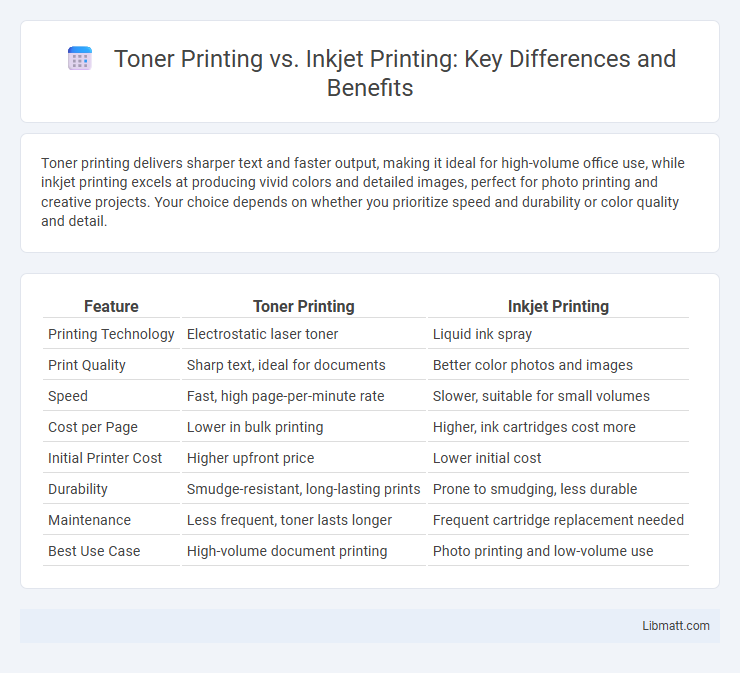Toner printing delivers sharper text and faster output, making it ideal for high-volume office use, while inkjet printing excels at producing vivid colors and detailed images, perfect for photo printing and creative projects. Your choice depends on whether you prioritize speed and durability or color quality and detail.
Table of Comparison
| Feature | Toner Printing | Inkjet Printing |
|---|---|---|
| Printing Technology | Electrostatic laser toner | Liquid ink spray |
| Print Quality | Sharp text, ideal for documents | Better color photos and images |
| Speed | Fast, high page-per-minute rate | Slower, suitable for small volumes |
| Cost per Page | Lower in bulk printing | Higher, ink cartridges cost more |
| Initial Printer Cost | Higher upfront price | Lower initial cost |
| Durability | Smudge-resistant, long-lasting prints | Prone to smudging, less durable |
| Maintenance | Less frequent, toner lasts longer | Frequent cartridge replacement needed |
| Best Use Case | High-volume document printing | Photo printing and low-volume use |
Overview of Toner Printing and Inkjet Printing
Toner printing uses powdered toner fused onto paper through heat, delivering sharp text and high-speed output ideal for office environments and large volume printing. Inkjet printing sprays liquid ink droplets directly onto paper, offering superior color accuracy and detail, making it perfect for photo and fine art printing. Understanding your specific needs will help you choose between the cost-efficiency and durability of toner printers or the vibrant color capabilities of inkjet printers.
How Toner Printers Work
Toner printers use a dry powder called toner, which is fused onto paper through a combination of heat and pressure, resulting in sharp, smudge-resistant prints. The laser in the printer creates an electrostatic image on a rotating drum, attracting toner particles that transfer precisely to your paper. This method enables faster printing speeds and higher durability compared to inkjet printers, making toner printers ideal for high-volume and professional-quality print jobs.
How Inkjet Printers Work
Inkjet printers work by propelling tiny droplets of liquid ink directly onto paper to create high-resolution images and text with smooth gradients and vibrant colors. This technology uses microscopic nozzles to spray ink precisely, making it ideal for photo printing and detailed graphics. You can expect excellent color accuracy and sharp details, although printing speed and ink cost tend to be higher than toner-based printers.
Print Quality Comparison: Toner vs Inkjet
Toner printing delivers sharp, crisp text and consistent image quality, making it ideal for professional documents and high-volume printing. Inkjet printing excels in producing vibrant colors and detailed photo-quality images, suitable for photo prints and artistic applications. Toner's durability and smudge resistance outperform inkjet, which can suffer from fading and bleeding on certain paper types.
Speed and Efficiency Differences
Toner printing uses laser technology that rapidly fuses powdered toner onto paper, offering significantly faster print speeds compared to inkjet printers, which spray liquid ink drop by drop. This speed advantage makes toner printers ideal for high-volume printing tasks, enhancing overall office efficiency and reducing wait times. Your choice between toner and inkjet should consider the need for quick, large-scale document production versus occasional printing with detailed color accuracy.
Cost Analysis: Toner vs Inkjet Printing
Toner printing generally offers lower cost per page compared to inkjet printing due to higher page yields and more efficient ink utilization, making it more economical for high-volume printing. Inkjet printers tend to have lower upfront costs but higher ongoing expenses since ink cartridges require frequent replacement and can be more expensive per page. Businesses prioritizing long-term savings often prefer toner printers despite the initial investment, as toner cartridges last longer and reduce overall printing costs.
Maintenance and Longevity
Toner printing systems, commonly used in laser printers, require less frequent maintenance due to the durability of toner cartridges and fewer moving parts, resulting in longer printer lifespan. Inkjet printers demand more regular upkeep such as printhead cleaning and cartridge replacement to prevent clogging and maintain print quality. Toner technology typically offers superior longevity and cost efficiency for high-volume printing environments compared to inkjet alternatives.
Best Use Cases for Toner Printers
Toner printers excel in high-volume printing environments such as offices and businesses due to their faster print speeds and lower cost per page compared to inkjet printers. They produce sharp text and graphics with high durability, making them ideal for printing professional documents, brochures, and labels. Toner printers handle heavy workloads efficiently and offer superior performance on standard paper, which enhances productivity in corporate and educational settings.
Best Use Cases for Inkjet Printers
Inkjet printers excel in producing high-quality photos and detailed color images, making them ideal for photographers, artists, and home users who prioritize vibrant, precise prints. They handle a wide variety of media types including photo paper, labels, and textured stationery, offering flexibility for creative projects and small-scale color printing needs. Your choice of an inkjet printer suits tasks requiring fine color gradients and sharp image quality rather than high-volume text printing.
Choosing the Right Printer for Your Needs
Toner printing offers faster print speeds and higher page yields, making it ideal for high-volume document printing, while inkjet printing provides superior color accuracy and detail, perfect for vibrant photos and graphics. Consider your typical printing tasks: choose toner printers for efficient black-and-white text output and inkjet printers for rich color images. Your decision should balance speed, quality, and cost per page to match your specific printing needs.
Toner printing vs inkjet printing Infographic

 libmatt.com
libmatt.com